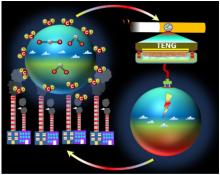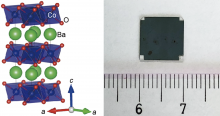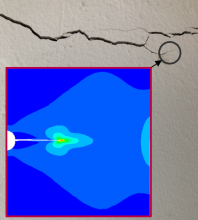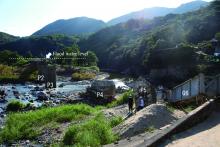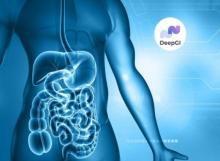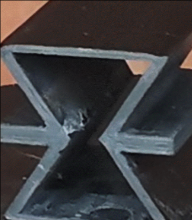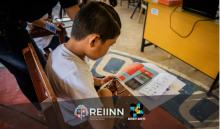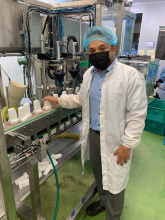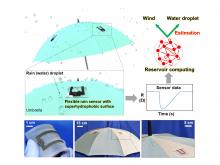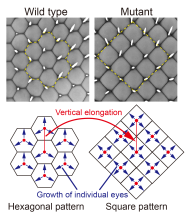Engineering & Technology
News
23 Jul 2022
Researchers create 'time machine' to study ancestor galaxies, Robotics engineers pay attention to matters of the heart, Custom suits for delivery worms, Tough, light structures with superior impact resistance and Virtual training can reduce stress and anxiety. Read all in the July's Editor's Choice plus op-ed: To boost South Korea’s basic science, look to values, not just budgets, this month's Image & Asia Research News 2022 magazine pick - Better memristors for brain-like computing.
19 Jul 2022
A research group has successfully synthesized a ‘half-metal’ material, achieving a rare feat in the pursuit of zero magnetization. The new material will enhance the performance of electronic devices thanks to the unique behavior of its spin.
18 Jul 2022
An international team of scientists from India and Singapore has successfully developed a novel method to recycle waste cigarette filters for use in making the triboelectric nano generator, a clean energy generating device.
15 Jul 2022
A research team co-led by City University of Hong Kong (CityU) have successfully developed a novel Vacuum Ultra-Violet (VUV) meta-lens which can generate and focus the VUV light, a disruptive technology for the UV optics market.
11 Jul 2022
A thermoelectric metal oxide film with a thermoelectric figure of merit of ~0.55 at 600°C has been discovered, opening new avenues towards the widespread use of thermoelectric converters.
07 Jul 2022
A novel practical way of modelling cracking and toughening of fibre composite materials has been developed. The novel approach also revealed new insights on the fracture behaviour of fibres reinforcing a composite laminate during intralaminar cracking. The new way can be used to complement inspection of laminated structures that are used as primary structures in many industries.
06 Jul 2022
Osaka University researchers described a novel effect in which the voltage generated by photovoltaic devices can change based on the color of incidence light. They show how this feature is due to random energy states that exist inside the antimony sulfiodide devices. This work may lead to more robust renewable energy generated by solar cells.
01 Jul 2022
SUTD research on predicting vocal tract geometry from spectral information opens doors to diagnosing vocal disorders non-invasively
01 Jul 2022
An international forum hosted by the Global Strategy Institute (GSI) at the Korea Advanced Institute of Science and Technology (KAIST) will examine two of the most difficult issues to fight in human history, inequality and injustice. World-renowned experts will provide new insights on how to understand the major forces behind increasing inequalities and social injustice and explore solutions to these intractable problems that are still affecting our world to this day. The 7th of its kind, KAIST GSI’s international forum will be held online on July 6th, 2022 from 9:00 until 10:30 am Korea Standard Time (KST) and livestreamed on KAIST’s YouTube Channel. The theme of the forum is “The Science of Inequality and Injustice.”
30 Jun 2022
Researchers at Kanazawa University report in The Journal of Physical Chemistry Letters how to simulate 3D atomic force microscopy images of out-of-equilibrium systems involving biomolecules. The approach makes use of a celebrated equation from thermodynamics applicable to non-equilibrium situations.
29 Jun 2022
Researchers analyze the collapse of the Misasa Railroad Bridge in Japan — an infrastructure failure caused by unprecedented flooding back in 2018 — to inform future flood-resistant designs.
28 Jun 2022
Chula Engineering and Chula Medicine co-invent an innovative device for a rapid and accurate gastrointestinal cancer detection hoping to foster preventive medicine and reduce the number of cancer patients.
27 Jun 2022
Osaka University researchers studied the effect of the “attitudes” of a semi-autonomous telepresence robot on its human operator. They found that when a person controlled only a part of the body of a semi-autonomous robot, its expressed opinions affected him or her. This work may help assist in the development of new semi-autonomous robots to perform labor more efficiently.
27 Jun 2022
Scientists at Tokyo Medical and Dental University have discovered a new type of bone repairing material that could be used to more precisely fix bone defects.
27 Jun 2022
Osaka University researchers develop a novel microfluidic chip that can detect very small concentrations of dissolved contaminants using just 100-picoliter sized samples. By using a terahertz point source, the detection area can be made very small. This work may lead to lab-on-a-chip technology for environmental and health care monitoring.
23 Jun 2022
Osaka University researchers used sputtered silver to bond copper electrodes as part of 3D integrated circuits. By gently annealing the silver layers, enough surface roughness was created to connect the layers without added pressure. This work may lead to cheaper and smaller electronic devices that use less energy.
20 Jun 2022
Osaka Metropolitan University scientists detected, for the first time, collective resonance at remarkably high and broad frequency bands. In a magnetic superstructure called a chiral spin soliton lattice (CSL), they found that resonance could occur at such frequencies with small changes in magnetic field strength. The findings suggest CSL-hosting chiral helimagnets as promising materials for future communication technologies.
09 Jun 2022
A high-level seminar-cum-networking event on Water Sustainability in Singapore was held on 21 April 2022 at Newcastle University Research & Innovation Institute Singapore (NewRIIS). The event saw the presence of representatives from Singapore's National Water agency PUB, Northumbria Water, NUCoRE Water and other organisations.
05 Jun 2022
An international team of researchers, led by Changfang Zhao, from Nanjing University of Science and Technology, has developed a novel lightweight, high toughness auxetic structure made from plastic composite laminates. The auxetic structure may be used for constructing primary structures in the transport industry, such as electric vehicles, to maximize fuel efficiency.
01 Jun 2022
Resilient Education Information Infrastructure for the New Normal (REIINN) project has commenced the construction of its first LokaLTE Base Station in San Andres Elementary School, Tanay, Rizal, 24 May 2021.
31 May 2022
The food manufacturing industry could save significant costs by employing a 3D printing solution developed by researchers at International Islamic University Malaysia.
26 May 2022
Empowering the innovators to transition their new inventions, technologies and products into manufacturing and commercialisation prospects
25 May 2022
A model that rapidly searches through large numbers of materials could find sustainable alternatives to existing composites.
16 May 2022
Researchers from the Osaka Metropolitan University Graduate School of Engineering have successfully developed a new technique allowing them to observe gas molecules packing into metal-organic frameworks (MOF) using infrared spectroscopy. Their innovation was to measure polarized light absorption of guest molecules in a MOF film to deduce molecule alignment using this common piece of lab equipment. This method is the first to show guest alignment and does so in real-time, while using an accessible and easily adoptable experimental setup. A short video (4 min) recreating their spectrometer modifications can be found in the Reference section.
13 May 2022
The new multi-tasking weather sensor simultaneously measures rain volume and wind speed. Incorporating machine learning to analyze the output data, a single sensor can provide localized weather data in a timely manner, improving disaster preparedness.
12 May 2022
Researchers at Osaka Metropolitan University and Osaka University used numerical simulations to confirm observations of quantized vortices in superfluid helium using silicon nanoparticles, improving understanding of quantum fluids and superconductors.
06 May 2022
2.5-dimensional materials promise new applications for artificial intelligence, electronics, automobiles and the energy sector.
28 Apr 2022
Lithium-ion batteries power our everyday products, from laptops to vehicles, because of their safety, longevity, and charging speeds. Yet their production relies on rare metals such as cobalt and nickel. Now, a research group has unearthed a potential method for incorporating more common and cheaper elements as synthesizing electrode materials.
26 Apr 2022
Researchers have established a low-cost method of magnetization reversal on perpendicularly magnetized ferromagnets. Not needing an external magnetic field, the method brings reverse magnetization closer to commercial viability.
20 Apr 2022
Tile patterns in which the same shape is laid out without gaps are found in the compound eyes of insects. Hexagonal tile patterns are common while shrimp eyes have a square pattern. We investigated tile pattern formation using Drosophila and revealed that the compound eye tile pattern is controlled by a geometrical division mechanism, Voronoi tessellation, in addition to physical constraints determined by the combination of the regular distribution and growth of the individual eyes.
Events
Sorry, nothing coming up for this discipline
- « first
- ‹ previous
- 1
- 2
- 3
- 4
Giants in history
Sorry, nothing coming up for this discipline




